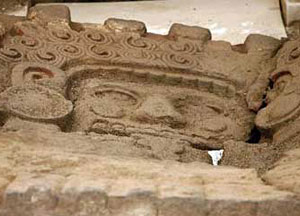 |
 |
 |
 Editorials | Environmental | January 2007 Editorials | Environmental | January 2007  
Pollution Threatens Pre-Aztec Mexican Ruins
 Reuters Reuters


| | A huge monolith depicting Tlaltecuhtli, the Aztec god of the earth. |
Oil refineries and power stations pumping acid air pollutants along Mexico's Gulf coast threaten to erase carved stone murals at the pre-Aztec ruined city of El Tajin, a scientist said today.

Air pollution specialist Humberto Bravo said acid levels in the air around El Tajin, in oil producing Veracruz state, were among the highest in Mexico.

El Tajin's architecture is famous for intricate reliefs, many depicting an ancient Mesoamerican ball game sometimes compared to basketball.

"If nothing is done, within 10, 20 or 100 years, the hieroglyphics will disappear," said Bravo, from Mexico's UNAM university.

Bravo, who spent four years simulating the effects of polluted air and acid rain on El Tajin's soft limestone buildings, blamed the erosion on contaminants like chlorine, sulfates and nitrates in the air from power stations and oil refineries.

Veracruz and neighbouring states are home to some of Mexico's most important oil facilities and ports.

The city was built on the tropical coast of Veracruz by the Totonac civilisation and was at its height from the early 9th to early 13th century.

The Aztecs, who ruled Mexico when the Spanish arrived, were at their strongest in the 13th and 14th centuries.

At its peak, the city, home to an elaborate niche-studded pyramid, was a power in an area that extended toward today's border with Texas and south into the realm of the Maya civilisation.

UNESCO listed it as a World Heritage Site in 1992. | 
 | |
 |



